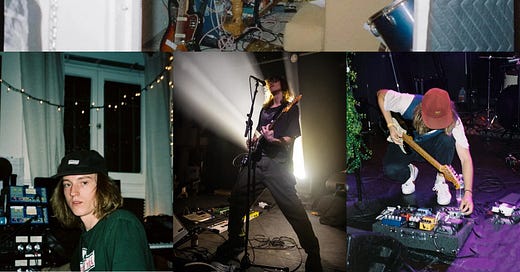It feels overdue for me to write about Mk.gee. You can hear his effect on music via his guitar production everywhere. I am not a guitarist so I don’t quite know technically what he’s doing that is so innovative, but I can speak from a sonic and emotional perspective. On his 2024 album, Two Star & The Dream Police, Mk.gee’s guitar sounds like a hybrid of an electric guitar, a standup bass, an electric violin, and an 80s synth. The compressed and disjointed nature of the way he plays instrument feels like it mimic’s both the mounting feeling of anxiety as well as the rush of a crush voicing that the feelings are reciprocated. This has proven to be an incredibly craveable tone to try and duplicate and many artists have tried both successfully and reductively. It seems that most guitarists who are making alt r&b are at least toying with sounds that feel inspired by his work. But where did it all begin?
For the first time on this publication, it really feels like the producer really just “had it” from the jump. On his first two albums, Pronounced McGee and Fool, all the proficiency that would make Mk.gee eventually blow up was already there. The only differences I can deduce were he used to use more acoustic patterns and straight rhythm guitar instead of truly sticking to that off kilter smoothness on every song. On his first album particularly, Mk.gee also went a bit dancier on some songs and lived in a more alt pop disco lane. On the second album, he fused that with a bit more soulful melancholy and there it was, the full Mk.gee effect. I had never gone back and listened to his early stuff before this search through the credits and genuinely think he should’ve been way bigger way earlier. It’s so rare that I think that.
Mk.gee’s first official producer credit for another came in 2019 between album two and album three in the form of “the climb” for the artist Role Model. Now, this is honestly such a funny first credit because this is a cover of a Miley Cyrus song from her Disney Channel days. Why did Mk.gee do this? Did he just get a super huge bag? Like it sounds solid and the acoustic guitar is sort of compressed-ish, but for the life of me I have no idea why or how this came together and would love to know.
Now, I can’t believe I’m saying this, but upon sonic review I think I like Mk.gee’s third project A Museum of Contradiction from 2020 more than any of his others, including Two Star & The Dream Police. What this project contains is a consistent undeniable groove to counterbalance the intentionally stilted instrumental movements. The whole project feels like watching the ocean move in high tide during sunset on a beach on the island of Crete. It’s as meditative as it is emotional.
Naturally, this album spurred a bit of a run for Mk.gee producing for others. Other artists for sure heard what I just did for the first time on album three in real time. Most notably he worked with Dijon on his opus effort Absolutely, which seems to have given him even more r&b edge moving forward. But he also cooked with The Kid Laroi, Jean Dawson, Seago, Vegyn, Kacy Hill, and most notably, Omar Apollo. That last guy and Mk.gee have a very clear overlap in tone. Some of that has to do with a clear sonic aesthetic alignment between Mk.gee and Apollo’s main producer Teo Halm, who I wrote about on ITC 017. Apollo and Halm’s 2024 single “Spite” was my favorite song of last year and the guitar feels super Mk.gee coded. No wonder, they worked together in 2020 on an album Calm also produced on.
Following up last year’s Two Star and the Dream Police, Mk.gee has released one awesome single “Rockman” and just recently produced a song for Jonah Yano called “Homerun 2021.” Yano had my favorite album of 2020 in real time, souvenir. Two pandemic musical savants colliding naturally resulted in magic. Mk.gee’s slick yet staggered guitar wraps around Yano’s rounded and warm vocal tone like a handmade wool blanket over your shoulders on that same Greek beach.
ITC 067 Mk.gee Playlists





